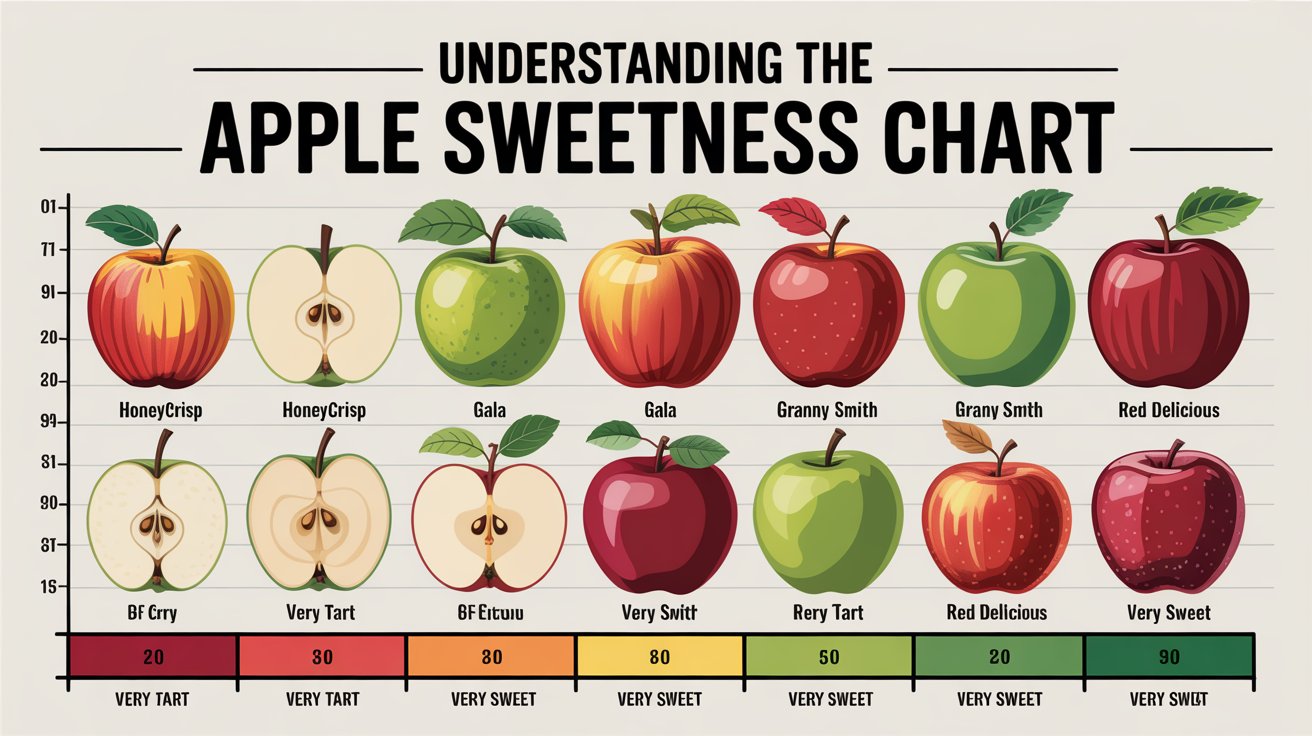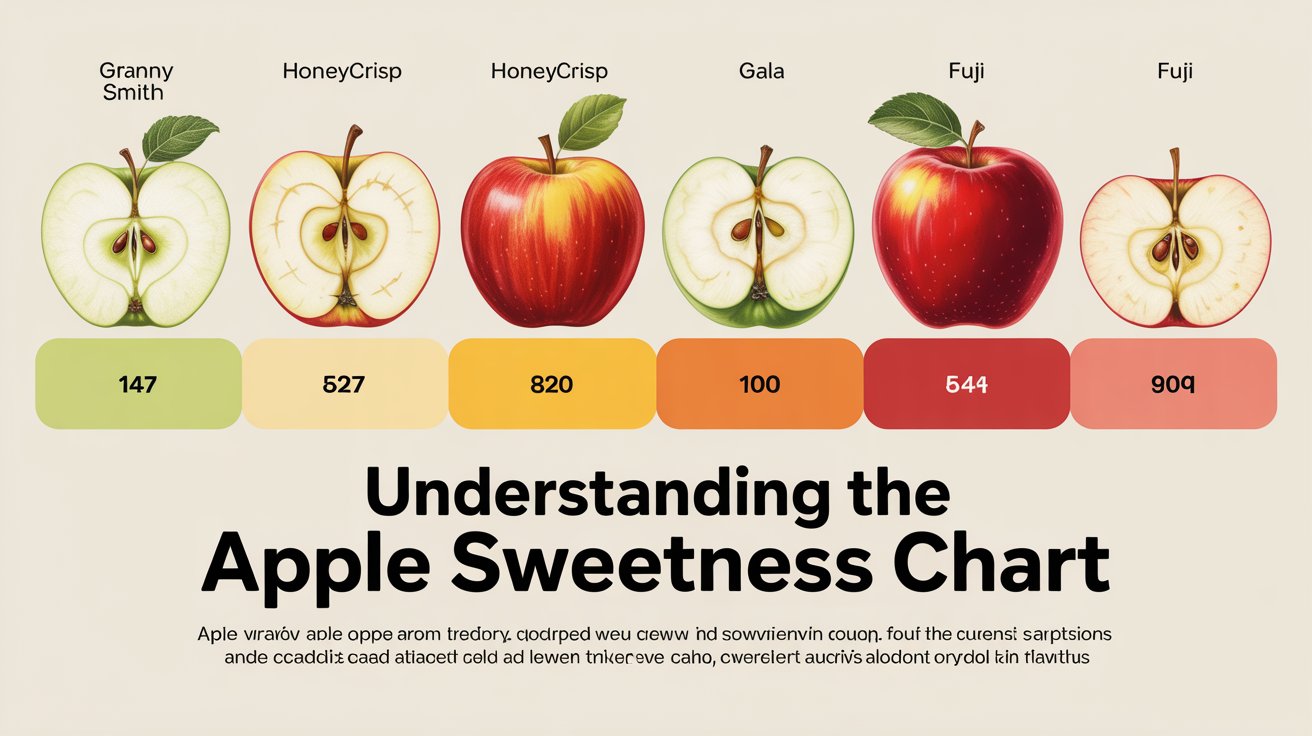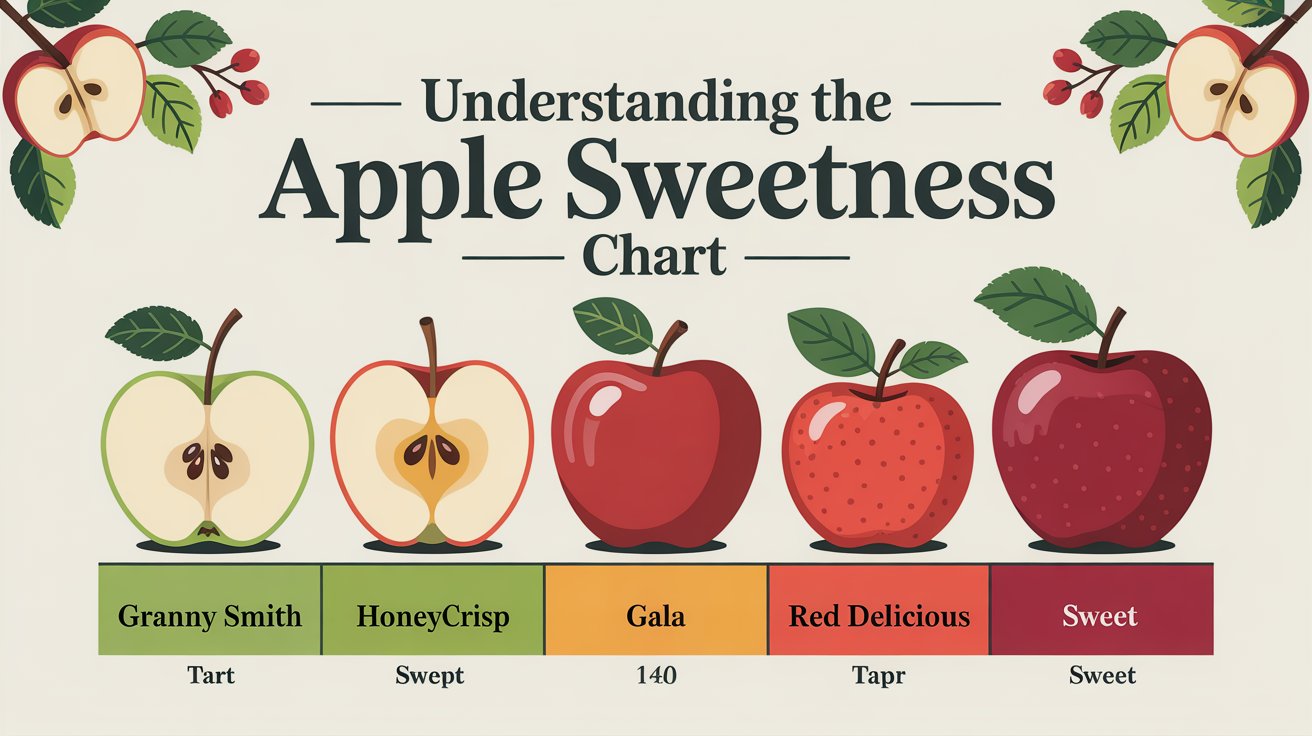Have you ever stood in a fruit aisle, looked at a shining pile of apples and wondered, “Which one will taste sweet, and which will give me that tart zing?” I’ve been there too. It’s like choosing which chocolate to pick—but for apples. If you’ve ever wished for a clear guide, you’re in luck. In this article we’ll dive into the apple sweetness chart, see how different varieties line up, and look at how you can use this info to pick the best apple for your taste and cooking.
Let’s walk through this fresh, friendly, and simple journey together.
What is an apple sweetness chart?
Think of the apple sweetness chart as a map that shows where each apple variety lies on the spectrum from very sweet to very tart. The chart helps you compare flavor profiles at a glance: which apples lean sugary, which carry more of a bite, and which sit somewhere in between. For example, one version of such a chart lists varieties like Fuji apple at the sweet end, and Granny Smith apple at the tart end.
Why is that helpful? Because if you like snacking on something sweet, you’ll know what to look for. If you’re baking or making a sauce and want something tart, you’ll know that too.
Why sweetness and tartness matter
So, why should we care about whether an apple is sweet or tart?
-
Taste preference: Some of us crave the candy-sweet bite, others prefer a sharper flavor that wakes up the palate.
-
Cooking use: If you’re making a pie, you may want an apple with more acid so the flavor holds up when baked. For fresh snacking, a sweeter, lower-acid apple might feel more like a treat.
-
Texture + flavor synergy: Sweetness isn’t only sugar—it’s how sugar, acid and texture come together. One apple may taste sweet because it’s mellow, low-acid, and crisp. Another may taste less sweet because the tartness out-balances the sugar.
Imagine sweetness like the warmth of sunshine, tartness like a refreshing breeze. Together they create a flavour climate.
How the chart is built: sugar, acid and texture

Here’s a breakdown of what goes into placing an apple on this sweet-to-tart spectrum:
Sugar content
Naturally, more sugar = sweeter taste. Many apples designated “sweet” have higher sugar levels.
Acid level
High acid brings tartness, which can suppress the perception of sweetness. For instance, Granny Smith is high in acid, making it notably tart.
Texture and crunch
How the apple feels in your mouth influences perceived sweetness: a crisp, juicy apple may deliver flavour differently than a soft, mealy one.
Growing & ripening conditions
Where and when the apple is grown, how ripe it is when harvested, will affect flavour. A warm season may yield a sweeter apple; a less ripe apple may taste more tart.
Basically: Sugar – Acid + Texture = flavour experience. The chart distills that into bite-size guidance.
Top sweet-apple varieties you should know
If your taste buds lean toward the sugary side, here are some star varieties:
-
Fuji – Often at the top of the sweetness scale. Very sweet, dense, crisp.
-
Gala – Mildly sweet with a nice snack appeal.
-
Golden Delicious – A mellow sweetness, good all-rounder.
-
Envy – A newer variety that features prominently as “extremely sweet.”
When you see an apple that’s described as “the sweetest variety” on the chart, these are the kinds you’re likely encountering.
Apples with balanced sweet-tart flavor
If you like a bit of sweetness but also enjoy a bite of acidity (a bit of tension in the flavour), look into:
-
Honeycrisp – Crisp, juicy, nicely balanced.
-
Pink Lady – Tart finish with notable sweetness; good for snacking or baking.
-
Jonagold – A mix of tart and sweet; very versatile.
These are apples that, metaphorically speaking, play both sides of the flavour seesaw: not too sweet, not too sharp.
The tart end of the chart: when acidity leads
On the other side of the spectrum are apples whose flavour is defined more by their acid / tartness than pure sugar. These varieties shine when you want something bold or cooking-friendly.
-
Granny Smith – The classic tart apple. High acid, crisp texture.
-
Braeburn – Balanced but tilting toward the tart side.
-
Jonathan – Crisp, tart, with a sweet hint; great for cooking.
Think of these as the zing in your apple world—the ones that wake up your palate or stand up to heat in the oven.
Using the chart for snacking vs. baking

One of the most useful applications of the sweetness chart is deciding how you’ll use the apple.
For snacking (fresh, raw)
You’ll likely prefer an apple with higher sweetness and pleasant texture—something crisp, juicy, and easy to bite. Sweet varieties like Fuji or Gala fit this nicely.
For baking, sauces, pies
You might want an apple that holds its shape, has enough acid to avoid becoming bland when cooked, and contrasts with sugar, spice or other flavours. Tart or balanced apples like Granny Smith or Jonagold often shine here.
For salads or cheese pairing
Here, you want flavour and firmness. Balanced sweet-tart apples that don’t mush easily are great. For example, Envy or Honeycrisp are often recommended.
So ask yourself: “Am I eating it raw now, or baking it later?” That question alone narrows the field.
How growing conditions affect sweetness
You might think: “But I bought Fuji apples and they didn’t taste super sweet.” Good point. The sweetness chart provides guidance, but real-world factors still matter.
-
Ripeness at harvest: If an apple is picked too early, sugar may not have fully developed.
-
Climate & soil: Warm, sunny growing seasons tend to produce sweeter fruit.
-
Storage & time: Some apples continue to develop flavor after harvest; others may lose freshness.
-
Variety vs. batch: Even within a variety, differences in orchard, tree age, and care will affect taste.
So the chart is your map—but your own orchard, market, or grocery store is the terrain.
Regional variety and seasonal timing
Another angle: when and where apples are grown affects availability and flavour. Many charts list peak-season info for each variety.
For example:
-
Some apples are summer/early-fall harvests; others are later and store longer.
-
Location matters: apples grown in cold climates vs warmer zones may have different acid/sugar profiles.
-
You might find imported apples in your region (depending on where you live) that have travelled and may have slightly different texture or flavour.
If you’re hunting for top sweetness, check local markets when the variety is in its prime.
Tips for storing and tasting apples at peak flavor
To get the best from that apple you’ve selected:
-
Pick firmly crisp fruit: A soft, mushy apple will often taste less flavourful.
-
Smell the apple: A fragrant aroma often means good sugar development.
-
Store properly: Refrigerate if possible; many apples last longer, maintain crispness.
-
Avoid bruises / soft spots: These can accelerate spoilage and affect flavour.
-
Taste with context: Try it raw, and then try it in a different way (slice, with cheese, baked). You’ll appreciate the spectrum.
-
When in doubt, try two: One sweet variety + one tart variety = fun contrast and helps your own palate learn.
Think of your apple selection like auditioning actors for a play: you want the best performance, and sometimes the star (sweet) and the character actor (tart) both shine in different roles.
Common myths about apple taste and sweetness

Let’s clear up a few misunderstandings:
-
Myth: “Red apples are always sweeter than green ones.”
Reality: Colour is not a reliable indicator of sweetness. For example, some red apples may still be tart, and some green ones (like certain imports) may be sweet. -
Myth: “Bigger apples taste sweeter.”
Reality: Size doesn’t equate to sugar content. Texture and ripeness matter more. -
Myth: “Cooking makes all apples taste identical.”
Reality: The variety still plays a role in baking, sauces or pies—sweetness and texture affect outcome.
So the sweetness chart helps you cut through these myths and pick with intent.
Summary and how to apply the sweetness chart in real life
Let’s wrap things up with a friendly summary:
-
The apple sweetness chart is a helpful tool that ranks apple varieties from sweetest to most tart, helping you match flavour with use.
-
Sweetness is shaped by sugar content, acid level, texture, ripeness and growing conditions.
-
If you love sweet, crisp apples for snacking, look to varieties like Fuji, Gala, Envy.
-
If you want a balance or something with a zing, varieties like Honeycrisp, Pink Lady, Jonagold are great.
-
If you’re baking or want bold flavour, tart apples like Granny Smith, Braeburn shine.
-
Use the chart when you shop: scan labels, ask about variety, and recall your taste preferences.
-
Factor in seasonality and local availability: the “sweeter” apples may taste best when truly in season.
-
Lastly, experiment! Your palate is unique, and the chart is a guide—not a rulebook.
So next time you pick apples, you’ll feel a bit like a flavour detective, armed with insight and confidence.
FAQs
1. What exactly counts as “sweet” in an apple?
Sweetness in an apple comes from naturally occurring sugars, but how we perceive it also depends on how much acid is present and how the apple feels when you bite into it. Apples that have high sugar and relatively lower acid taste sweeter.
2. Can I rely on colour or size to tell how sweet an apple is?
No, not reliably. While some apples with sweeter profiles may share common appearance traits, colour and size are not consistent indicators of sweetness. Texture, variety and ripeness matter more.
3. Are sweet apples always better for baking?
Not always. For baking you often want apples that hold their shape, provide flavour contrast, and tolerate heat. Sometimes a tart apple or a balance between sweet and tart works better than a very sweet one that might become mushy.
4. How can I use the sweetness chart when I shop for apples?
Start by identifying your use (snack vs bake), then check the variety label. Use the chart to pick a variety that matches your preference. Try one or two and take note of how it tasted — that helps you build your personal “sweetness map”.
5. Does storage affect how sweet an apple tastes?
Yes. Apples stored properly maintain better texture and flavour. If an apple is stored too long, gets soft or shriveled, its perceived sweetness and overall quality can drop. Also, some varieties continue to develop flavour after harvest.









